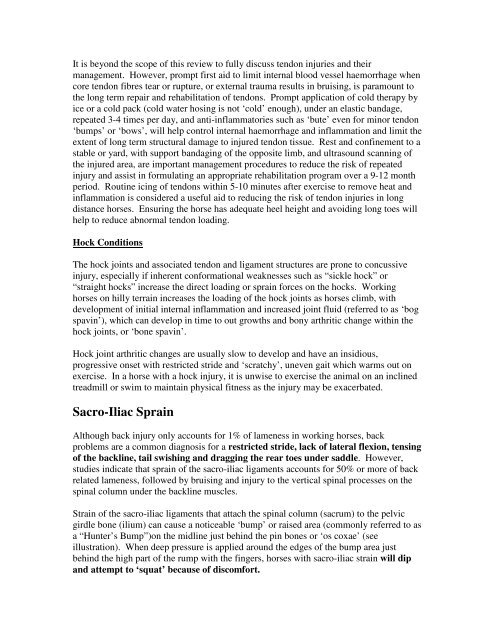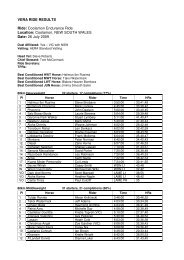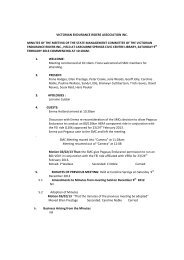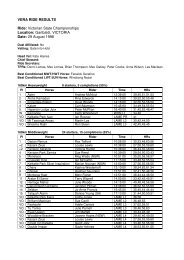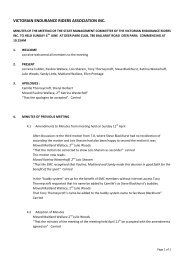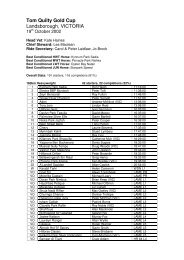Common Lameness Problems In Endurance Horses - Australian ...
Common Lameness Problems In Endurance Horses - Australian ...
Common Lameness Problems In Endurance Horses - Australian ...
Create successful ePaper yourself
Turn your PDF publications into a flip-book with our unique Google optimized e-Paper software.
It is beyond the scope of this review to fully discuss tendon injuries and their<br />
management. However, prompt first aid to limit internal blood vessel haemorrhage when<br />
core tendon fibres tear or rupture, or external trauma results in bruising, is paramount to<br />
the long term repair and rehabilitation of tendons. Prompt application of cold therapy by<br />
ice or a cold pack (cold water hosing is not ‘cold’ enough), under an elastic bandage,<br />
repeated 3-4 times per day, and anti-inflammatories such as ‘bute’ even for minor tendon<br />
‘bumps’ or ‘bows’, will help control internal haemorrhage and inflammation and limit the<br />
extent of long term structural damage to injured tendon tissue. Rest and confinement to a<br />
stable or yard, with support bandaging of the opposite limb, and ultrasound scanning of<br />
the injured area, are important management procedures to reduce the risk of repeated<br />
injury and assist in formulating an appropriate rehabilitation program over a 9-12 month<br />
period. Routine icing of tendons within 5-10 minutes after exercise to remove heat and<br />
inflammation is considered a useful aid to reducing the risk of tendon injuries in long<br />
distance horses. Ensuring the horse has adequate heel height and avoiding long toes will<br />
help to reduce abnormal tendon loading.<br />
Hock Conditions<br />
The hock joints and associated tendon and ligament structures are prone to concussive<br />
injury, especially if inherent conformational weaknesses such as “sickle hock” or<br />
“straight hocks” increase the direct loading or sprain forces on the hocks. Working<br />
horses on hilly terrain increases the loading of the hock joints as horses climb, with<br />
development of initial internal inflammation and increased joint fluid (referred to as ‘bog<br />
spavin’), which can develop in time to out growths and bony arthritic change within the<br />
hock joints, or ‘bone spavin’.<br />
Hock joint arthritic changes are usually slow to develop and have an insidious,<br />
progressive onset with restricted stride and ‘scratchy’, uneven gait which warms out on<br />
exercise. <strong>In</strong> a horse with a hock injury, it is unwise to exercise the animal on an inclined<br />
treadmill or swim to maintain physical fitness as the injury may be exacerbated.<br />
Sacro-Iliac Sprain<br />
Although back injury only accounts for 1% of lameness in working horses, back<br />
problems are a common diagnosis for a restricted stride, lack of lateral flexion, tensing<br />
of the backline, tail swishing and dragging the rear toes under saddle. However,<br />
studies indicate that sprain of the sacro-iliac ligaments accounts for 50% or more of back<br />
related lameness, followed by bruising and injury to the vertical spinal processes on the<br />
spinal column under the backline muscles.<br />
Strain of the sacro-iliac ligaments that attach the spinal column (sacrum) to the pelvic<br />
girdle bone (ilium) can cause a noticeable ‘bump’ or raised area (commonly referred to as<br />
a “Hunter’s Bump”)on the midline just behind the pin bones or ‘os coxae’ (see<br />
illustration). When deep pressure is applied around the edges of the bump area just<br />
behind the high part of the rump with the fingers, horses with sacro-iliac strain will dip<br />
and attempt to ‘squat’ because of discomfort.


